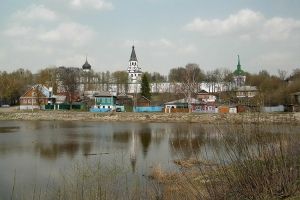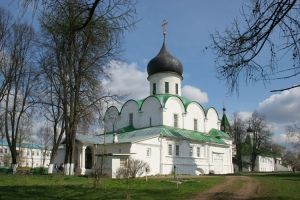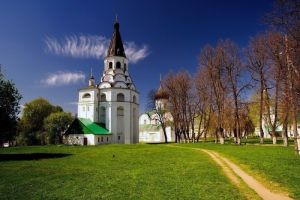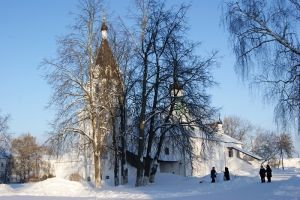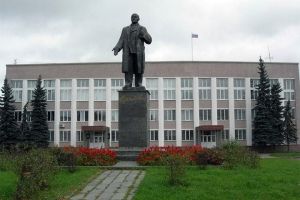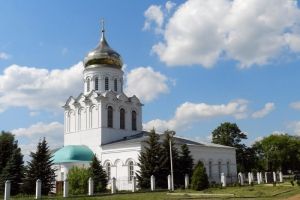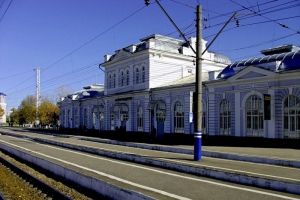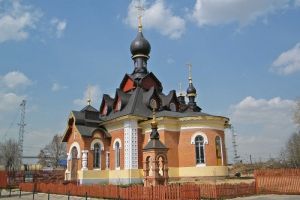Alexandrov
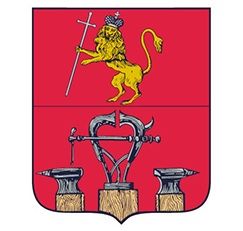
The city of Alexandrov is the administrative center of the Alexandrov district, the fourth largest city in the Vladimir region with a population of 59,787 people (2016). It has satellite towns Strunino and Karabanovo, together with which it makes up the Alexandrov agglomeration with a population of about 112 thousand inhabitants. Located on the river Seraya (Gray), 125 km north-west of Vladimir, 111 km north-east of Moscow on the railway line Moscow-Yaroslavl. Alexandrov is included in the Golden Ring of Russia.
History
There were Slavic settlements since the end of the 11th century, on the territory where Alexandrov is located now. These lands were part of the Vladimir-Suzdal principality in the middle of the 12th century, then – part of the Pereslavl-Zalessky principality (1175-1302), and then passed into the possession of the Moscow princes. In accordance with the policy of Ivan Kalita, in the 1320s these lands became actively populated by settlements (sloboda). The settlement, which was on the site of the present city, is mentioned as the Great Sloboda in the documents of the 14th-15th centuries. Since the beginning of the16th century, the names New Alexandrov village and Alexandrov Sloboda appeared in relation to this settlement.
Ivan III in the spiritual charter of 1504, bequeathed the village to his son Basil – the future Grand Duke Basil III. It became a favorite resting place during princely trips to monasteries. Alexandrov Sloboda quickly built up with the help of the best Russian and Italian masters. It turned into a luxurious suburban residence of Basil III by 1513. Thus, in 2013 Alexandrov Sloboda celebrated its 500th anniversary.
The most vivid and tragic at the same time page in the history of Alexandrov Sloboda is connected with the reign of Ivan IV the Terrible, who turned it from the country residence, which it was under his father, Vasily III, to the capital. For seventeen years, from December 1564 to November 1581, Alexandrov Sloboda served as the actual capital of the state. Oprichny orders, the Oprichnaya Boyar Duma and a number of other institutions functioned in it. Sloboda became a place for international negotiations and signing of agreements in the foreign policy of Ivan IV. But state affairs alternated with torture and executions of the oprichnina's enemies in the gloomy dungeons of the sloboda. Alexandrov Sloboda witnessed many events and dramas of the royal family.
Alexandrov Sloboda went down in history also as a cultural center of the 16th century, which left priceless creations to the future generations. Chronicles were created and the first books were printed here, icons were painted and bells were cast, musical works were created, the best architects built white-stone temples and magnificent palaces.
In 1581, after a bloody family drama and the death of his eldest son Ivan IV, Ivan the Terrible left Aleksandrov Sloboda quickly and did not appear in it any more.
At the beginning of the 17th century, in the Time of Troubles, Sloboda was badly damaged by the Polish-Swedish intervention: in 1609 and then in 1611-1612 it was in the power of the detachments of hetman Sapieha. After liberation of the country from foreign invasions Sloboda was a pile of ruins, especially the Kremlin, palaces, temples. By the year 1635, a new wooden palace was built for Tsar Mikhail Fedorovich, which existed for almost a hundred years, burned down and was no longer restored.
In the second half of the 17th century, under Tsar Aleksey Mikhailovich Romanov, the women's Holy Assumption Monastery was organized on the site of the ruined Kremlin. The nuns dismantled the ruins of the royal buildings of the 16th century and used this material for the construction of a cell building, fences, repair of churches. The monastery was visited by many representatives of the Romanov dynasty, since Alexandrov Sloboda remained a palace village.
Not far from the Sloboda, which went to Peter I in the division of the sovereign villages between brothers, on the German Hills, the 17-year-old tsar conducted his foot and horse amusing teachings. After the suppression of the Streltsy’s rebellion in 1689, according to the order of Peter I, his stepsister Marfa Alekseevna was tonsured to the Assumption Monastery, accused of involvement in the insurrection. She lived as a prisoner for almost ten years in a stone chamber of four rooms, attached to the Crucifixion church-belltower.
The daughter of Peter I Elizaveta Petrovna (future empress) inherited Alexandrov Sloboda as personal possessions from her mother. During the reign of Anna Ioanovna (1730-1740), she actually was here in exile and lived in specially built for her mansions. At the end of the 1740s, under the order of Empress Elizabeth Petrovna, the first school was opened for servicemen of the Alexandrov stud farm.
The expositions of the State Historical, Architectural and Art Museum-Reserve "Alexandrov Sloboda" tell about the history of Sloboda, its royal regiments and noble guests, monastery life on the site of the former royal residence.
In 1778, the former palace Alexandrov Sloboda was granted the status of the county town of Alexandrov, in the Vladimir vicegerency. Metal vise and two anvils on either side, under the provincial lion on a red background, were depicted on the coat of arms, granted to the city in 1781. This symbolized the handicraft nature of the city, since Sloboda was famous for its artisans. In 2006, when approving the Charter of the city, the historical coat of arms of Alexandrov was approved as the official coat of arms of the city of Alexandrov.
Small economic weight of the city at the end of the 18th century led to a fact that in 1796 Alexandrov was turned into an ordinary settlement (posad), and only in 1803 the city status was restored with the preservation of the previously established coat of arms.
In the first half of the 19th century the history of the city is closely connected with the dynasties of merchants and manufacturers Baranovs and Zubovs who contributed to the development of weaving in Alexandrov and nearby villages. In 1808, on the left bank of the river Seraya merchant D. Zubov laid the first dyeing and printing factory (in the future – the plant "Iskozh"). In August 1823, the city was passed by the Emperor Alexander I, and he stayed at the house of the merchants Stepan and Michael Zubovs, best for those times (now – Streletskaya Embankment, 11).
F.N. Baranov, merchant of the third guild, bought a plot of land in the town in the 1810s, built a house on it and a small dyeing for fabrics. In 1834, he expanded the dye factory, where cotton yarn and fabrics were painted in a bright red color. The history of this factory is notable for the five-day armed uprising of the workers in December 1905, which was called the "Alexander Republic". In honor of this event in 1987, a monument was erected in Alexandrov (next to the Nativity of Christ church). And the weaving factory in 1922 received the name of the worker F.I. Kalinin, one of the organizers of the uprising.
In 1846 I.F. Baranov established the Troitsko-Aleksandrov spinning and weaving manufactory in the village of Karabanovo near Alexandrov (later – the Combine named after the Third International). In 1847, after the Petersburg Fair, Nicholas I granted I.F. Baranov's right to depict on his commodity labels the state emblem, for his great contribution to the development of manufactory production in Russia and high quality fabrics. The Baranov chintzes were known all over Russia, and in 1862 – were awarded medals at an industrial exhibition in London.
In 1874, A.I. Baranov founded a large textile enterprise in the village of Strunino, named Sokolovskaya Manufactory (later – the Combine "Fifth October"). These largest weaving enterprises in Russia were constantly expanding, workers' settlements with social infrastructure (dormitories for workers, hospitals, schools, shops, churches, etc.) were formed around them, which today became the industrial towns-satellites of Alexandrov – Karabanovo and Strunino.
A powerful stimulus for the development of Alexandrov's economy was the construction of the Moscow-Yaroslavl railway in 1870, which allowed local goods to have free access to markets. A brick building of the railway station and the adjacent station complex – storage buildings, a luggage compartment, a building for remote signal communication, a village of railway workers – were built in Aleksandrov, as a large railway junction, in 1903. Alexandrov Railway Station became one of the best along the entire branch of the Moscow-Yaroslavl railway, and today it is a historical and architectural monument of the city.
Economy
In the 20th century, Alexandrov became one of the most developed industrial centers in the Vladimir region. In 1924 the Alexandrov-Vladimir cotton trust of union value was created, which included weaving factories named after F.I. Kalinin, named after the Third International (Karabanovo) and "Fifth October" (Strunino).
In 1932 a radio plant No. 3 moved from Moscow to Alexandrov, which marked the beginning of the development of the radio engineering industry in the city. It produced first-class radios SVD-1, SVD-9, SVG-K, etc. During the Great Patriotic War – radio stations for the needs of the Soviet army. In the post-war period, the plant established the production of mass receivers "ARZ", "Record", since 1949 – TV-sets "KVN-49", and since 1950 – TV-sets "Record". In the 1950s-1980s, the Aleksandrov radio plant became a city-forming enterprise: it employed over 12.5 thousand people. In these years, every tenth TV, produced in the country, was from Alexandrov.
In the 1990s, the radio plant experienced enormous economic difficulties. In its former industrial areas, several different industries and organizations have been established, which are still functioning today. This, in particular, the Aleksandrov Electrotechnical plant "Record", which produces lamps of the brand "Technolux". On the territory of the former Aleksandrov radio plant, a multidisciplinary machine-building enterprise "Graviton" was created in 1990, which produces equipment for electric trains of Russian Railways and city electric transport, and various electrical products.
One of the largest enterprises of the city was a semiconductor plant named after the 50th anniversary of the USSR (later, the PO "Eleks"). Today it is SPC "Daleks", producing transistors and integrated circuits, energy-saving lamps "Daleks", welding machines, refrigeration equipment.
One of the oldest enterprises of Alexandrov is the Artificial Leather Combine (Iskozh, founded in 1808), which was the first in the country to master the technology of making imitation leather. Since 1954, the only one in the Soviet Union, it produced an artificial doodle. In 1987, the plant for the first time in the country began the production of knitted cotton gloves with PVC coating for the protection of hands. Since 1990 it mastered the production of linoleum (the joint production line Switzerland-Italy). The company "Alexandroviskozh" continues to produce small amounts of artificial soft leather (awning and upholstery materials), linoleum, but is experiencing great economic difficulties.
In the late 1950s, the All-Union Scientific Research Institute for the Synthesis of Mineral Raw Materials (VNIISIMS) was created in Alexandrov, producing artificial quartz crystals, technology and products of which for a long time had no analogues in the world. It also manufactured crystal products – diamond tools, quartz resonators, crystal blanks of various sections. Significant interest in the production of high-precision instruments was represented by single crystals of semiconductor diamond. Artificial gems, analogues of natural stones, used in jewelry business, were also produced. Unfortunately, the enterprise went bankrupt in 2007.
One of the newest enterprises of Alexandrov is the large Russian factory of the Turkish company "Vestel", which produces LCD TVs, washing machines, refrigerators, cookers, dishwashers and air conditioners.
Alexandrov – "the capital of the 101st kilometer"
In the 20th century Alexandrov was also known as the "capital of the 101st kilometer": during the years of Stalin's political repression, many figures of science and culture and human rights activists were forced to live in the city, because after being released from prisons and camps, they did not have the right to settle in cities less than 100 kilometers from Moscow. Among them were, for example, the artist Victor Toot, the translator Boris Leitin, the architect and archaeologist Peter Baranovsky, the physicochemist Lev Polak and others. Alexandrov was the ideal residence in this situation, as it located just 111 km from Moscow. From here one could at least occasionally sneak out to Moscow to meet with relatives, receive help, visit theaters, etc.
Famous people
Many famous people of Russia are connected with Alexandrov. In the early 20th century Russian writer A.I. Tsvetaeva lived in Alexandrov, often visited by her older sister, the famous poetess M.I. Tsvetaeva (now in the house where they lived, there is the Literary and Art Museum of Marina and Anastasia Tsvetaevs). In Alexandrov were born: A.K. Gertsyk (1874-1925) – Russian poetess, prose writer, translator; V.P. Zubov (1900-1963) – Russian and Soviet historian, philosopher, doctor of art history, encyclopedist and translator, who entered the history of the humanities of Russia as "Russian Leonardo", thanks to the depth and versatility of his scientific interests, etc. The Honorable Citizen of Aleksandrov O.V. Danilova – Russian skier, honored master of sports, two-time Olympic champion, four-time world champion in ski races – lives in the city.
Sights
Alexandrov, as a city with an ancient history, has a lot of attractions, interesting for tourists. This is, first of all, the palace and temple complex of the Aleksandrov Sloboda, which is part of the museum of the same name. Prominent monuments of Russian architecture are preserved on its territory: the earliest stone temple of Alexandrov – the Trinity Cathedral (1513); the first stone tent old Russian temple of the beginning of the 16th century – the Intercession Church; the Crucifixion church-belltower (1560-ies) and Marfa’s Chamber (the 17th century); the Assumption Church (the 16th-17th centuries). The complex is surrounded by powerful walls with four corner towers and the gate church of Fyodor Stratilat (1680s), belonging to the Assumption women's monastery of the 17th century.
There are other architectural monuments in the central part of the city: the Nativity Cathedral (1696), the Church of the Bogolyubsky Icon of the Mother of God (1800), the estate of the merchant A.M. Pervushin of the 19th century, which houses the Alexandrov Museum of Art.
 Tourism portal of the
Tourism portal of the